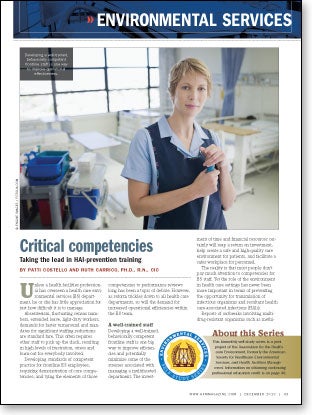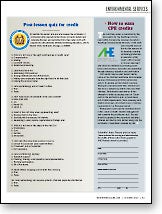Critical competencies
 Unless a health facilities professional has overseen a health care environmental services (ES) department, he or she has little appreciation for just how difficult it is to manage.
Unless a health facilities professional has overseen a health care environmental services (ES) department, he or she has little appreciation for just how difficult it is to manage.
Absenteeism, fluctuating census numbers, extended leave, light-duty workers, demands for faster turnaround and mandates for significant staffing reductions are standard fare. This often requires
other staff to pick up the slack, resulting in high levels of frustration, stress and burn-out for everybody involved.
Developing standards of competent practice for frontline ES employees, requiring demonstration of core competencies, and tying the elements of those competencies to performance reviews long has been a topic of debate. However, as reform trickles down to all health care departments, so will the demand for increased operational efficiencies within the ES team.
A well-trained staff
Developing a well-trained, behaviorally competent frontline staff is one big way to improve efficiencies and potentially minimize some of the stresses associated with managing a multifaceted department. The investment of time and financial resources certainly will reap a return on investment, help create a safe and high-quality care environment for patients, and facilitate a safer workplace for personnel.
The reality is that most people don't pay much attention to competencies for ES staff. Yet the role of the environment in health care settings has never been more important in terms of preventing the opportunity for transmission of
infectious organisms and resultant health care-associated infections (HAIs).
Reports of outbreaks involving multidrug-resistant organisms such as methicillin-resistant Staphylococcus aureus (MRSA), Acinetobacter baumannii and Clostridium difficile have demonstrated the critical nature of achieving and maintaining a hygienic environment for patients and health care personnel.
How hard can it be to clean the health care environment right? What will requiring competencies do to the pay scale? Will human resources (HR) buy into it? The answer to the last question is probably "yes" if a well-crafted business case is presented. Perhaps the larger question is, "What is more cost effective: practice-based competencies and a bit higher pay for performance in the short term or increased risk of poor-quality cleaning increasing the possibility of pathogen transmission or higher turnover due to lack of motivation?" The link among staff development, employee satisfaction and staff retention has been established for some time, but many organizations fail to treat the whole issue of staff retention in a strategic way.
Organizations that respect, value and invest in staff are more productive and significantly more profitable, and the evidence shows that high levels of employee satisfaction have a corresponding link to high levels of customer satisfaction. In short, happy ES workers often lead to happy patients. Additionally, the cost of hiring a new ES worker is significantly high, but the cost of replacing that employee could average as much as one to one-and-a-half times the year's salary for that position.
 |
| Click the above image for the Post-lesson quiz for credit |
While this may not be a key factor in the current economy, ES typically has a high rate of turnover compared with that of other departments. Some turnover is healthy and a means by which to regroup and re-energize, but it also can be unhealthy. For ES departments, it's the unhealthy part that is of concern for two reasons: work redistribution within the department and new staff lacking the skills to do the job properly. The latter is what the Association for the Healthcare Environment (AHE), formerly the American Society for Healthcare Environmental Services, has zeroed in on.
AHE infection partnership
Shortly after publishing the first edition of Practice Guidance for Healthcare Environmental Cleaning (PGHEC), AHE partnered with researchers from the University of Louisville (UofL) and infection preventionists to evaluate the PGHEC in terms of infection prevention practice competencies. Under the direction of the UofL team, the competencies were developed by a group of professionals in infection prevention and environmental services. The practice competencies then were used as the basis of the evaluation of the PGHEC. The research project outlined the following seven basic practice competencies:
- To describe the role of microorganisms in disease;
- To describe how microorganisms are transmitted in health care settings;
- To demonstrate standard and transmission-based precautions for all patient contact in health care settings;
- To describe occupational health practices that protect the health care worker from acquiring infection;
- To describe occupational health practices that prevent health care workers from transmitting infection to a patient;
- To demonstrate ability to solve problems and apply knowledge to recognize, contain and prevent infection transmission; and
- To describe the importance of health care preparedness for natural or man-made infectious-disease disasters.
A full written report was provided by the UofL researchers and that information confirmed that practice guidance is, indeed, steeped in competent practice, knowledge and skill. The report also identified specific areas of the competency-based materials and related them to the aforementioned seven competency statements. The report further provided feedback regarding gaps where additional information was indicated.
To that end, AHE staff and the AHE Knowledge Management Committee reviewed the first edition of the PGHEC and cross-matched the seven practice competencies to the required work, thus forming the basis for the second edition of Practice Guidance. This edition will include, but is not limited to, the following elements:
- Depth of explanation regarding the role the environment plays in microorganism transmission;
- Principles of asepsis (clean vs. dirty and sterile vs. nonsterile); and how to distinguish among clean, disinfected and sterile processes;
- More information regarding hand hygiene and various products and procedures that are available for use and when they should be employed;
- Information regarding patient placement and transport and how that impacts the safety of ES workers;
- Signs and symptoms of infection that may impact the health and safety of ES workers;
- Steps to employ in the event of an exposure to blood or other potentially infectious material;
- The role of immunization in infection transmission; and
- Emergency preparedness and the need to ensure consistent practice as part of routine job performance.
As AHE prepares to release the second edition of the PGHEC, this and additional information will be incorporated into the PGHEC and will provide additional help to environmental services from the management to the practice level. The goal is to ensure a competent and safe workforce as professionals collaborate to provide a safe environment for patients, health care personnel and our communities. To keep track of continuing developments, log on to the AHE website at www.ahe.org.
A smart move
While requiring competency-based training and education for ES staff is only one strategy to help create a safe environment for patients and personnel, it's a prudent one for HR and ES management to discuss actively. HFM
Patti Costello is executive director of the Association for the Healthcare Environment (AHE), formerly the American Society for Healthcare Environmental Services. She can be contacted at pcostello@aha.org. Ruth Carrico, Ph.D., R.N., CIC, is assistant professor, Office of Community and Professional Service, School of Public Health and Information Sciences, University of Louisville (Ky.). She can be reached at rmcarr04@louisville.edu.
| Sidebar - For more information |
| Need more information on the environmental services staff competencies? The resources listed below were used by the author when preparing this article. • Centers for Disease Control and Prevention's Guideline for Disinfection and Sterilization in Healthcare Facilities, William A. Rutala, David J. Weber, and the Healthcare Infection Control Practices Advisory Committee, 2008 • "Measures to control and prevent Clostridium difficile infection", D.N. Gerding, C.A. Muto and R.C. Owens. Clinical Infectious Diseases, Vol. 46 (Suppl 1):S43-49, 2008 • "Transmission of viral infections through animate and inanimate surfaces and infection control through chemical disinfection," Syed A. Sattar, and V. Susan Springthorpe, Chapter 8 in: Modeling disease transmission and its prevention by disinfection, Christon J. Hurst, ed. Cambridge, England: Cambridge University Press, 1996:224-57 • Association for Professionals in Infection Control and Epidemiology's Guide to the Elimination of Clostridium difficile in Healthcare Settings, Washington, D.C., 2008 • "Routine disinfection of patients' environmental surfaces. Myth or reality?" S. Dharan, P. Mourouga, P. Copin, G. Bessmer, B. Tschanz, and D. Pittet, Journal of Hospital Infection, Vol. 42, No. 2, 1999 • "Infection prevention and control competencies for hospital-based healthcare personnel," Ruth M. Carrico, Terri Rebmann, Judith F. English, JoEllen Mackey and Sherill Nones Cronin, American Journal of Infection Control, Vol. 36, No. 10, 2008 • "Does training increase employee retention?" William O. Umiker, Medical Laboratory Observer, Vol. 26, No. 4, 1994 |


